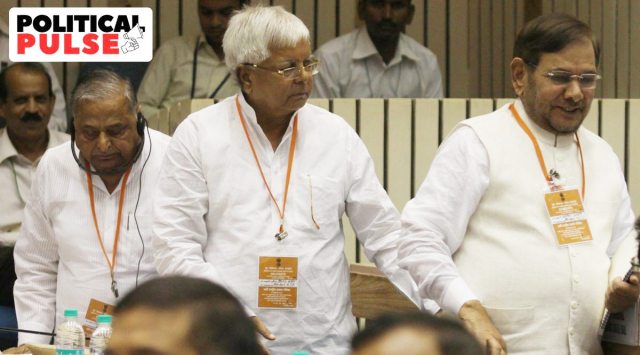
The senior most of the three, Mulayam became an MLA for the first time in 1967, at the age of 28, winning as a candidate of the Socialist Party, which was part of the larger anti-Congress umbrella put together by Ram Manohar Lohia. The latter’s Sansopa or Sanyukta Socialist Party gave the slogan, “Sansopa ne bandhi gaanth, pichhade paaven sau mein saath (Sansopa has resolved that OBCs should get 60% of the total).
Few years after the demise of Lohia, Mulayam joined Chaudhary Charan Singh who had quit the Congress in April 1967.
Around the time Mulayam was finding his way into politics, Sharad Yadav rose as president of the students’ union at his alma mater Jabalpur University. While he would later graduate in Electrical Engineering, Sharad was caught up in the anti-Congress wave stirred by several student movements. He was picked and won a by-poll from Jabalpur for the Lok Sabha in 1974 on a Bharatiya Lok Dal (BKD) ticket.
Jabalpur seat had been represented till then by Seth Govind Das, a Congress stalwart and author, whose death in June 1974 led to the bypoll. By this time, the student movement against the Indira government was already at its peak, particularly in Gujarat (where it was called Navnirman Andolan) and Bihar, where Jayprakash Narayan started the Sampurna Kranti (Total Revolution) agitation. Sharad had served a term in jail, and socialist stalwarts like Madhu Limaye convinced Jana Sangh leaders like Atal Bihari Vajpayee and Nanaji Deshmukh, who backed the student movement, to field Sharad.
He contested as a candidate of the joint Opposition, and victory was a big win for the JP Movement.
Story continues below this ad
Like Sharad, Lalu Prasad was a product of student politics, heading the union at Patna University before joining the JP Movement and entering the Lok Sabha from Chhapra in 1977.
Sharad and Lalu were both under 30 when they first became MPs.
In 1977, when Sharad won his second election to the Lok Sabha as part of the anti-Indira Gandhi sweep, the Janata Party government was formed in UP, and Mulayam was sworn in as Minister of Cooperatives.
All born in the first two waves of anti-Congress politics in the country (Mulayam in the first wave after 1967 and the other two pre-Emergency), the three were jailed during the Emergency. The trial by fire helped them rise as leaders, particularly in the late Eighties when the Janata Parivar parties – splintered into many groups – made a fresh bid to topple the Congress.
Story continues below this ad
When V P Singh resigned from the Rajiv Gandhi government to form the Janata Dal, Mulayam, Sharad and Lalu went with him, besides the late Ram Vilas Paswan and Nitish Kumar. When V P Singh formed the government on December 2, 1989, Sharad was appointed Minister of Food Processing Industries and Textiles while Mulayam and Lalu became CMs, respectively, of UP and Bihar in close succession.
Since the two became CMs, the Congress would not return to power in either UP or Bihar – attesting to the strength of the OBC front weaved by them.
The height of this was the implementation of the Mandal Commission report, to ensure 27% reservation for OBCs in government jobs. The three, along with Paswan and Nitish, played key roles in ensuring the implementation went through – despite hurdles.
It was also under the V P Singh government that the Bharat Ratna was conferred on Dr Bhimrao Ambedkar.
Story continues below this ad
While the Mandal politics would eventually be taken over by the Ram temple agitation of the BJP, both Mulayam and Lalu would earn their stripes standing in its way. In October 1990, the Mulayam Singh government in UP would open fire on kar sevaks trying to stop them from heading to the Babri Masjid in Ayodhya. Days later, Lalu would stop the Rath Yatra launched by L K Advani for the temple, causing the BJP to pull out its support for the V P Singh government and making it collapse.
With OBC politics still maintaining its relevance, the numerical strength of the Yadavs in UP and Bihar with them, and given the trust they had earned of the minorities, Mulayam and Lalu were able to hold on to their forts.
It was to get around them that a new formula of “non-Yadav OBC” was framed by parties like the BJP, and also saw the rise of leaders from weaker sections among other parties to challenge the Yadav “hegemony”.
Sharad, however, could not create his own space. Among very few leaders to have been elected to the Lok Sabha from three different states (Jabalpur in Madhya Pradesh, Badaun in UP and Madhepura in Bihar), he remained dependent on other parties for his electoral success. And finally ran out of friends by 2019, the last Lok Sabha polls he contested, and lost.
Story continues below this ad
While they moved on to different political paths, the opinion of the three Yadavs on issues like women reservation, caste census, reservation, secularism and several other issues remained the same.
As for the ties between them, they were not always good. CPI(M) leader Harkishan Singh Surjeet once said that in 1997, when the Congress withdrew support to the H D Deve Gowda government, among the alternatives suggested was Mulayam. But Lalu vetoed the same, clearing the way for I K Gujral to take over.

































